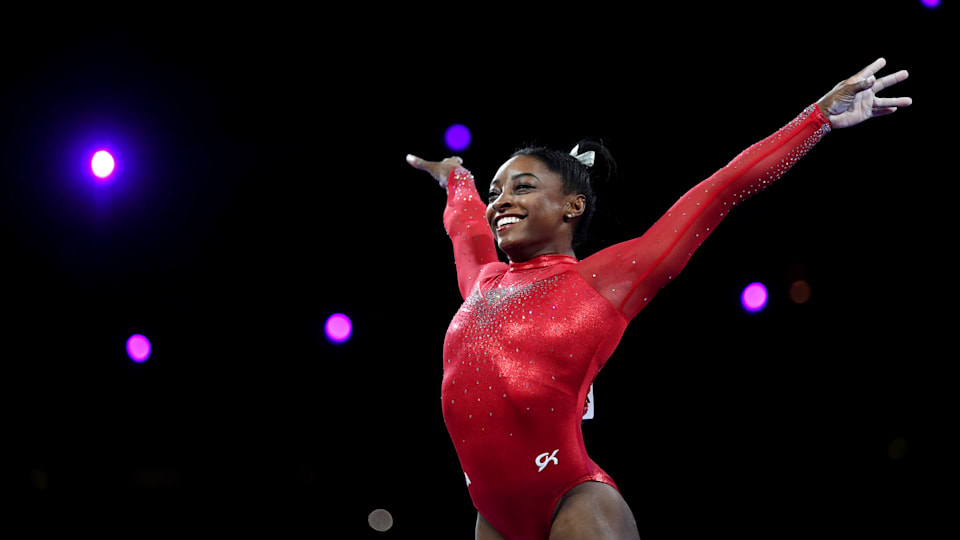
Scoring
In men’s and women’s artistic gymnastics, the final score displayed is composed of two different components: the execution and the difficulty scores. At major international competitions, like the World Championships and Olympic Games, five judges make up the execution panel while two calculate the difficulty score.
The execution score retains the traditional 10.0 system fans are likely familiar with. Each routine starts from a 10.0 with judges on the execution panel removing points for errors such as steps on landings, missed handstands, or even one full point for a fall.
For the difficulty score, each routine starts at zero. They earn points in three different ways. First, for each of four composition requirements, the athlete is awarded 0.5 up to 2.0.
Next, gymnasts earn more points based off the difficulty of the elements in their routines. Each element in gymnastics is valued from A, worth 0.1, to J, which receives 1.0. In women’s gymnastics, each routine receives credit for the eight most difficult elements, while the men count 10.
The final way a gymnast can add to his or her difficult score is through connection value. If an athlete performs two difficult elements together – say two catch and release moves on the uneven bars – they receive addition tenths of points for the combination.
Apparatus
Men compete in six different apparatus: floor exercise, pommel horse, still rings, vault, parallel bars and horizontal bar. The apparatus norms, set by the International Gymnastics Federation (FIG), are as follows:
- Floor exercise: The performance area measures 12 m by 12 m, with the diagonals equal to 16.97 m
- Pommel horse: The pommel horse body is 160 cm by 35 cm, and the apparatus is 115 cm high
- Still rings: The rings hang 2.8 m off the ground and are set 50 cm apart. The larger ring tower, where the ring straps are attached, must be 5.8 m high. The distance from the top of the ring tower to the bottom of the rings, is 3 m
- Vault: The surface of the vault is 95 cm wide by 120 cm long. Gymnasts are allowed a 25 m run up, but are not required to use all of it. For men, the vaulting height is set to 135 cm
- Parallel bars: The parallel bars are each 3.5 m long and are 2 m off the ground. Their width can be adjusted to the athletes’ preference with a minimum width of 42 cm and a maximum of 52 cm. The bar is an oval that must be 5 cm high and 4 cm wide
- Horizontal bar: The horizontal bar measures 2.4 m long and is 2.8 m above the ground. The bar itself has a diameter of 2.5 cm
For the women, there are four events: vault, uneven bars, balance beam and floor exercise.
- Vault: The vault specifications for the women are the same as the men, except the height is set to 125 cm for women
- Uneven bars: The higher of the two bars in women’s uneven bars is 2.5 m above the ground, while the lower bar is 1.7 m. The distance between the bars is variable, depending on each gymnast’s preference but must be between 1.3 and 1.8 m. Each bar has a diameter of 4 cm
- Balance beam: The balance beam is 10 cm wide, 1.25 m high and 5 m long
- Floor exercise: The performance area measures 1200 cm by 1200 cm, with the diagonals equal to 1697 cm (+/- 5 cm)
Performance
Only three routines in artistic gymnastics have a time limit: men’s floor exercise (70 seconds) and women’s balance beam and floor exercise (90 seconds). Routines running over the maximum timing receive a 0.1 penalty.
Women’s floor exercise is the only event set to music. Gymnasts typically pick their own music in consultation with their coaches, a choreographer and, sometimes, judges. The gymnastics code of points specifies three main categories for evaluating floor exercise performance: artistry, composition and music/musicality.
All Around
Follow three of the world’s top gymnasts - Morgan Hurd (USA), Angelina Melnikova (Russia), Chen Yile (China) - as they balance life as teenagers with dreams of winning gold at Tokyo 2020. All Around gymnastics documentary series offers unique access to the every day lives of artistic gymnasts.
While evaluating an athlete’s artistry is subject, the gymnastics rule book provides certain examples as follows.
- Artistry of performance
- Inability to reflect musical theme, to play a role or character throughout the performance
- Performance of the entire exercise as a series of disconnected elements & movements
- Composition
- Incorrect selection of movements for a particular music (e.g. “Tango” music, but “Polka” movements)
- Music and musicality
- Editing of music (e.g. no opening, ending, or accents)
- Lack of synchronization between movement and musical beat during a part of the exercise
Competition format
Major international meets, such as the Olympic Games, are divided into multiple rounds, which award medals in the team competition, individual all-around and each individual apparatus.
The first phase of competition is called ‘qualification.’ This round determines the finalists for each of the medal rounds.
In the team competition at the Olympic Games, four athletes will compose each team and all four will compete on each apparatus with the top three scores counting in qualifying. Eight teams advance to the final, where the format will be three athletes on each with all three scores counting.
The top 24 athletes advancing to the individual all-around final and eight to each of the individual apparatus finals, with no more than two per country in any of the individual finals.
